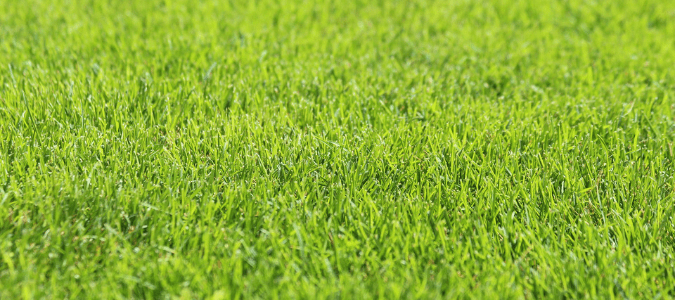
In the heat of a Texas summer, it can feel like keeping your grass green is a full-time job—which makes sense when you learn that even warm season species prefer temperatures in the 70s. It may seem like after you miss one day of watering, all of a sudden there are brown spots everywhere. Looking at what appears to be a dying lawn, you may realize you’re not completely sure how to keep your lawn green in the summer heat.
As you might suspect, the most important thing you can do for your lawn during the hottest times of the year is to water. In most Texas lawns, watering between a half-inch to a full inch of water each week can keep grass species that are suited for our climate healthy even in high temperatures. Bermuda grass and buffalo grass can handle just a half-inch of water, as well as other types of grass that aren’t exposed to full sun throughout the day, while other species will require more moisture to thrive. Grass will need less water when in humid, cool and less windy conditions.
If you are certain that you’re watering your grass the right amount, but your lawn is still not looking its best, your problem could be the time of day you’re watering or how often you set your sprinklers to run. Water in the early morning, so that you lose less moisture to evaporation, and so that your plants aren’t wet for too long, since that can make them more vulnerable to disease.
As you stare out at your sprinklers going off, you may be wondering: How often should I water my lawn with a sprinkler system? Irrigate deeply, since shallow watering can lead to a weak root system which is less capable of tolerating drought stress. Established, well-nourished grass can go 5 to 8 days between watering sessions—and sometimes, even longer. Many Texas towns have water restrictions in place which restrict watering to only a few times a week. A great resource for homeowners is the Water My Yard online tool, which uses real-time data gathered across Texas to help inform your sprinkler runtimes.
Rather than sticking to an established schedule, to keep your yard looking its best and conserve water you can look at your lawn to determine when you need to water next. Drought-stressed grass can look dull, with a bluish tint. Leaf blades will begin to roll or fold, and you may notice your footprints remain on the grass after you have walked across your lawn. When you decide it’s time to run your sprinklers, check to make sure that your system is delivering water in droplets, rather than a mist, since you tend to lose more water if pressure is too high. Have your irrigation system checked annually by an experienced technician to ensure your system is operating at peak efficiency.
While watering should be the biggest focus of your summer lawn maintenance, there are other things you also need to keep up with. Keep reading for more tips on how you can keep your grass looking great throughout the summer.
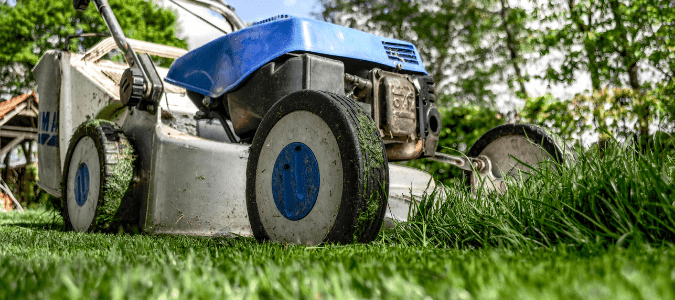
How Short To Cut Your Grass In The Summer
When it comes to mowing, during the summer months you’ll want to raise your mower blade. Why? Taller grass tends to have deeper roots, which allows plants to more easily access nutrients and withstand the demands of drought conditions. In addition, taller grass blades mean more shade, which discourages the growth of weeds, which compete with your turf for valuable moisture and food.
You can mow warm-season grasses—St. Augustine, Zoysia, Bermuda grass and Buffalo grass—to between two and three inches tall during the hottest times of the year. Ryegrass, tall fescue and bluegrass are cool-season grasses and can be mowed to as high as your blade can go, or between three and four inches. Allow leaf clippings to remain on the lawn to help your landscape retain moisture. As with any time of year, avoid mowing more than a third of the grass blade at a time. Also, ensure that your mower blades are sharp, so that you are cutting and not tearing your grass, as this can add extra stress to your plants at an already challenging time of year.
Keep in mind that both mowing and watering needs in residential areas can vary widely, especially in a state as big as Texas. If your lawn is still struggling during the summer months, despite your best efforts, try calling in a lawn care professional to see if there is something else going on with your grass.
Now that you know more about how to water and mow during the summer, let’s discuss a lawn maintenance schedule for this time of year.
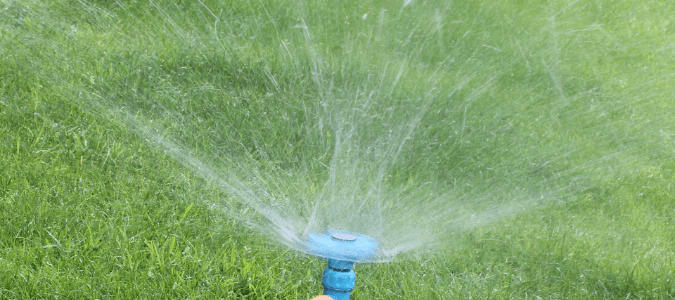
Summer Lawn Care Schedule: Tips From The Experts
The way you spend your time in your yard during the summer won’t vary significantly from month to month. Here are the key areas to focus on during this time of year.
Water Deeply And Infrequently
In most parts of Texas, scorching temperatures and infrequent rainfall mean that your lawn can quickly become parched and dry. Adjust your watering schedule from the spring months to increase the amount of moisture delivered to your turf, based on the rainfall in your area and the condition of your grass. Have your irrigation system inspected, if you haven’t already, to ensure all parts are in working order and you don’t have any leaks or broken sprinkler heads.
Keep a closer eye on your lawn so you can proactively water any dry spots, as needed, especially on the warmest days. You may want to try hand watering in particularly hot areas, such as near sidewalks. You’ll need to water newer, less established grass and plants more frequently. Apply water to your landscape so that moisture goes all the way down into your grass’s root systems, which is usually around 6 inches deep. This usually translates into one to two inches of watering once or twice a week. Resist the urge to overwater, since that can make your plants more vulnerable to pest damage and disease and your landscape can become more dependent on more water. Have someone check on your yard if you head out of town for summer trips.
Let The Grass Grow
Despite your preference to stay inside in the air conditioning rather than spend time mowing the lawn, this is one task you’ll want to keep up during the summer months. Use a mulching mower so that your grass clippings remain on your lawn, adding important nutrients.
Sharpen your mower blades once a month in advance of the growing season. As we have already mentioned, raise your mower height to avoid putting an added stress on your lawn. While some species may grow slower during the hotter times of year, you’ll probably find you’ll be cutting your grass more frequently during the summer. Taller, denser grass will help your landscape retain moisture and discourage weed growth. You can let your turf grow as much as 50% higher in the shade.
Fertilize Carefully
Once you start recognizing the first signs of summer, it’s time to start applying fertilizer. The amount of fertilizer you will need is going to vary, depending on the level of maintenance you want to put in. As you might expect, low maintenance landscapes demand the least of a homeowner, providing basic protection from weeds and helping maintain a dense layer of grass. Moderate maintenance will enhance the quality and appearance of your lawn, while highly visible or high-traffic yards can benefit from a high maintenance approach. A few of the factors that determine how much fertilizer you need, and in what proportions, include how much foot traffic your lawn gets and the degree of sun exposure. Warm-season grasses typically do best with the following fertilization schedule:
- Low maintenance: Apply in the spring or in the late growing season. One to two applications should be adequate.
- Moderate maintenance: In addition to the one to two regular applications, apply fertilizer once or twice more in the middle of the summer.
- High maintenance: In addition to the three to four regular applications, apply two to three supplemental applications as needed.
If things start to look drab and brown, it can be tempting to overfertilize your lawn. Adding too much fertilizer, especially during the summer months, can burn your lawn and encourage growth at the most difficult time of year for plants to become established. If you’re really starting to worry about your lawn, reach out to a professional for a consultation. A lawn care expert will be able to test your soil and recommend a year-round fertilization schedule that can give your grass the right mix of nutrients at the right times of the year.
Watch For Weeds, Pests And Disease
Some of the damage you see on your lawn during the summer months may be because of pests and disease and not stress related to the heat, and weeds can also appear during this time of year. Grubs may become a bigger problem in the middle of the summer, so you may need to apply an insecticide to affected areas during this time if you notice damage or pest activity. These products usually also help with chinch bugs.
Proper drainage will help prevent summer lawn diseases, so make sure water does not collect in certain parts of your yard. If you are wondering whether damage on your lawn is drought stress or chinch bugs, try hand watering these spots for a few days. If the grass does not recover, bring in a lawn professional to determine whether you need to treat impacted areas for chinch bugs.
If you did not apply a pre-emergent herbicide during the spring, you may need to use a weed control product as grass or broadleaf weeds appear in your yard. The type of treatment is highly dependent on the type of weed you have in your yard, so proper identification is key to a successful outcome. Keep in mind that applying any products during the hottest part of summer can add further stress to your landscape, so hand-pulling weeds may be your best tactic.
If you don’t relish the idea of spending time out in the summer heat on your lawn, you aren’t alone. Many homeowners outsource lawn care to a trusted local provider. Experienced technicians have a deep understanding of local conditions, water requirements, grass types, soil quality and other conditions that can make it harder to keep your landscape healthy during the often unforgiving Texas summers.
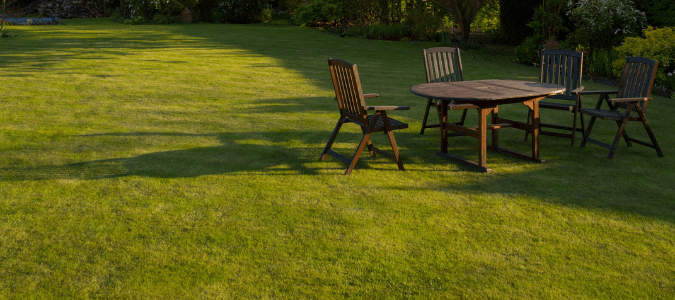
Best Time To Water Grass In Texas: Other Considerations
As we have discussed previously, the early morning is the best time to water your yard. Water pressure tends to be good, moisture is applied more evenly to your plants and grass and there is less evaporation when compared to the middle of the day. In addition, watering at night can make your grass more susceptible to pest damage and disease. Homeowners find that outdoor areas do better during the summer months if they are watered only a few times a week, with longer watering cycles. The cycle-soak method to split up watering into more, shorter sessions, can reduce run-off and provide the deep watering that Texas lawns need.
Even if your mowing, watering and fertilizing are working in perfect harmony, there are other things that could prevent your lawn from being bright and green. A few other factors to consider in proper lawn maintenance include thatch management, aeration and your landscape design.
Thatch Management
First of all—what is thatch? Thatch is the layer of intermingled dead and living organic matter that accumulates between the surface of the soil and the grass. This top layer of your turf is usually composed of dead leaves, roots and grass. While some thatch on your lawn is beneficial in aiding its growth, if you have too much thatch, food and water cannot penetrate to the roots of your grass.
So, how much thatch is too much thatch?
Ideally, your lawn should have a half inch of thatch for optimal growth. You can prevent the excess build-up of thatch by raking your lawn or by purchasing or renting a dethatcher machine. Other ways to prevent the build-up is by maintaining the pH level of your soil and aerating your lawn when necessary, which are two services that your lawn care professional can help you with.
Aeration
Over time, your soil can become compacted, which keeps air, food and water from absorbing down into a plant’s root system. When the grass is actively growing, you can aerate your lawn with a specialized machine, or hire someone to do it for you. You’ll want to make sure you remove soil and not create holes on your lawn which create more compacted spots. After you have aerated high-traffic areas, top dress your grass with compost and water it so that air flow is maintained and the soil quality enhanced.
Landscape Design
Did you know that you can use design to “cheat” your way into a great lawn?
Consider the setup of your lawn and how much grass is exposed to full sun. There may be some areas you can add shade to bring high-maintenance grass some relief. You can also add stepping stones or additional pavement to high traffic areas. This will give your friends and family somewhere to step without stomping on your grass.
As you might imagine, the type of grass in your yard can have a huge impact on whether it can survive the demands of summer in hotter parts of the country. Different types of grass require different amounts of fertilizer, water and maintenance. Here in Texas, Zoysia grass is a species that requires very little maintenance. If your lawn is significantly more of a hassle than you can handle, you can talk to a professional about which Zoysia grass type is best for your lawn or what other design elements can be added to make your lawn better able to withstand the demands of the summer months.
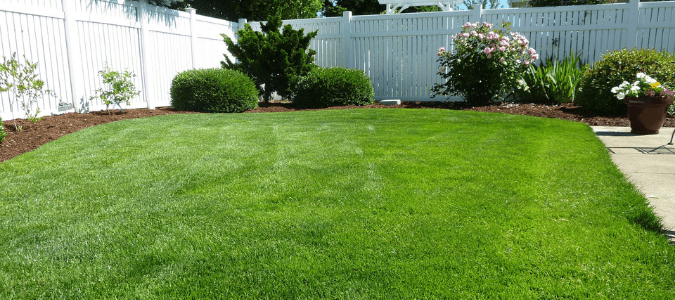
ABC Can Keep Your Grass Healthy And Looking Great
Every lawn is different, and sometimes it takes a professional’s help to keep your grass looking its best during the hot Texas summer. At ABC Home & Commercial Services, we can set up a maintenance schedule that keeps your lawn healthy—not just through the summer, but year-round. We do everything from regular mowing, to fertilizing to ensuring your sprinklers are working as efficiently as possible. With ABC’s help, you can enjoy a lawn that’s the envy of the neighborhood without lifting a finger.